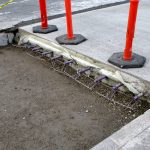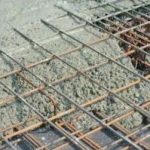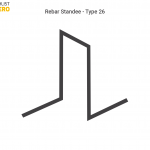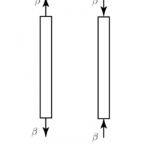The strength of rebar depends on its grade and the type of steel it is made from. This article reviews rebar’s typical construction and strength values, a rebar strength chart, and rebar testing standards.
Typical Construction and Strength Values
The strength of rebar can change based on its grade, the most common being grades 40, 60, and 75. The two major properties used to distinguish rebar are yield and tensile strength. Tensile strength is how much the steel can resist breaking under tension. Yield strength is the maximum strength that can be applied before it permanently changes shape. These properties are essential for engineers to determine what material to use and to calculate the maximum force that it can withstand.
- Grade 40
- minimum yield strength; 40,000 psi (pound-force per square inch)
- Minimum tensile strength: 60,000 psi
- Grade 60
- minimum yield strength: 60,000 psi
- Minimum tensile strength: 90,000 psi
- Grade 75
- Minimum yield strength: 75,000 psi
- Minimum tensile strength: 100,000 psi
Rebar Strength Chart
| Rebar Grade | 40 | 60 | 75 | |||||
| Yield/Tensile Strength (ksi) | 40 | 70 | 60 | 90 | 75 | 100 | ||
| US/Soft Metric | Diameter (in) | Area (in2) | Minimum Yield Force (kip) | Minimum Tensile Force (kip) | Minimum Yield Force (kip) | Minimum Tensile Force (kip) | Minimum Yield Force (kip) | Minimum Tensile Force (kip) |
| 3 / 10 | 0.375 | 0.11 | 4.4 | 7.7 | 6.6 | 9.9 | 8.3 | 11 |
| 4 / 13 | 0.5 | 0.2 | 8 | 14 | 12 | 18 | 15 | 20 |
| 5 / 16 | 0.625 | 0.31 | 12.4 | 21.7 | 18.6 | 27.9 | 23.3 | 31 |
| 6 / 19 | 0.75 | 0.44 | 17.6 | 30.8 | 26.4 | 39.6 | 33 | 44 |
| 7 / 22 | 0.875 | 0.6 | 24 | 42 | 36 | 54 | 45 | 60 |
| 8 / 25 | 1 | 0.79 | 31.6 | 55.3 | 47.4 | 71.1 | 59.3 | 79 |
| 9 / 29 | 1.128 | 1 | 40 | 70 | 60 | 90 | 75 | 100 |
| 10 / 32 | 1.27 | 1.27 | 50.8 | 88.9 | 76.2 | 114.3 | 95.3 | 127 |
| 11 / 36 | 1.41 | 1.56 | 62.4 | 109.2 | 93.6 | 140.4 | 117 | 156 |
| 14 / 43 | 1.693 | 2.25 | 90 | 157.5 | 135 | 202.5 | 168.8 | 225 |
| 18 / 57 | 2.257 | 4 | 160 | 280 | 240 | 360 | 300 | 400 |
Strength by Material Type
There are also a variety of types of rebar that contain different properties. The type of application and specifications, determine the specified rebar. For example, carbon or stainless steel will most likely be chosen if a rebar standee needs to be used to support concrete. Cost, strength, weight, and resistance to corrosion are all properties to consider when choosing rebar. The most common types include:
- Carbon steel – The most common type of rebar for residential and commercial projects. Used because of its durability and cost-effectiveness.
- Stainless steel – Great alternative to carbon steel used for bridges, roads, piers, and other weight-supporting structures. Although more expensive than carbon steel, it has preventative properties to corrosion.
- Galvanized – On the more expensive side, alloy steel dipped in zinc is extremely resistant to corrosion and holds up well during shipping and installation.
- Glass fiber reinforced polymer(GFRP) – Used in projects with high water exposure. It’s lighter, stronger, and less corrosive than traditional steel rebar.
- Epoxy coated – The thick epoxy coating helps slow corrosion in high-humidity and high-moisture environments.
- Welded wire fabric(WWF) – Made up of welded low-carbon steel in a grid pattern.
- Expanded Metal – Metal mesh that is used when thick plaster is needed to support the concrete. Used for sidewalks or walking surfaces.
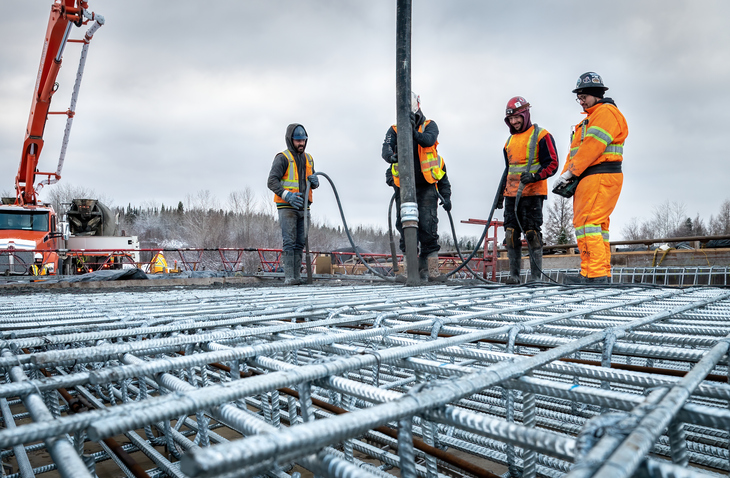
Rebar Manufacturing Process
The process for making rebar is similar regardless of the grade and type. Steel is melted down and pulled through round openings to give it its shape. The steel used for rebar is generally recycled steel scraps from old cars, appliances, and machinery. The general steps for making rebar are as follows:
- Steel scraps are melted at temperatures of up to 1,800 degrees Fahrenheit.
- Molten steel pours into the tundish and is then fed into a caster to avoid splashing. The caster shapes the metal into billets.
- The larger billets are hot rolled into smaller shapes inside the roughing mill.
- A rolling mill forces the billets into their final shape.
- The rebar cools and is cut to the desired length.
- Rebar is then packed and shipped to the customer.
Rebar Testing Standards
Rebar reinforces concrete to support structures and buildings. Such an important function requires the rebar to meet a certain standard. There are a number of standard tests that rebar may undergo:
- Mass per Meter – Technicians create four samples of 1-meter-long rebar. The average length of the bars is calculated from a minimum of 4 sides and weighed. The average weight is compared to the theoretical weight based on the grade of the rebar.
- Bend test – The rebar is bent 180 degrees and checked for any cracks, ruptures, or tears. If none of these are present, the rebar passes.
- Rebend test – Technicians bend the bar to 135 degrees and are left alone until it cools. Then it is bent back to 157.5 degrees, checking for any cracks, ruptures, or tears.
- Tensile Test – To ensure that the rebar reaches the right tensile strength, a sample piece will be placed into a machine and put under stress until it breaks. This gives valuable information like yield strength, tensile strength, and breaking strength.
While the above tests are the most common, construction companies may specify specific requirements to which the rebar must adhere. Regional and local building codes may require specific tests as well. For instance, the California Building Code (CBC) requires sampling and physical testing of rebar in concrete and masonry construction.
